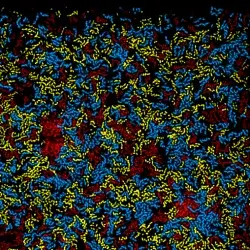
The Search for Habitable Worlds: Planetary Exploration in the 21st Century
The search for and detailed characterization of habitable environments on other worlds – places where liquid water, heat/energy sources, and biologically important organic molecules exist or could have once existed – is a major twenty-first-century goal for space exploration by NASA and other space agencies, motivated by intense public interest and highly ranked science objectives identified in recent National Academy decadal surveys.
E pluribus unum: From Complexity, Universality
In a brief survey, Terence Tao discusses some examples of the fascinating phenomenon of universality in complex systems, in which universal macroscopic laws of nature emerge from a variety of different microscopic dynamics.
Small Machines
Over the last fifty years, small has emerged as the new big thing. The reduction of information and electronics to nanometer dimensions has revolutionized science, technology, and society. Now scientists and engineers are creating physical machines that operate at the nanoscale. Using approaches ranging from lithographic patterning to the co-opting of biological machinery, new devices are being built that can navigate, sense, and alter the nanoscale world. In the coming decades, these machines will have enormous impact in fields ranging from biotechnology to quantum physics, blurring the boundary between technology and life.
Can We Progress from Solipsistic Science to Frugal Innovation?
Energy demand in the twenty-first century will be driven by the needs of three billion people in the emerging world and three billion new inhabitants to our planet. To provide them with a renewable and sustainable energy supply is perhaps the greatest challenge for science in the twenty-first century. The science practiced to meet the energy needs of the twentieth century responded to a society of wealth, and energy systems were designed to be large and centralized.
The Future of Fundamental Physics
Fundamental physics began the twentieth century with the twin revolutions of relativity and quantum mechanics, and much of the second half of the century was devoted to the construction of a theoretical structure unifying these radical ideas. But this foundation has also led us to a number of paradoxes in our understanding of nature.
Microbes as Menaces, Mates & Marvels
The conventional understanding of microbes as causative agents of disease has led us to fear them and to consider them our deadly enemies. Much less appreciated are the central roles microbes play in shaping the environment and in maintaining plant, animal, and human health. All metazoan organisms – organisms that we can see with the naked eye – exist in lifelong partnerships with vast microbial communities.
Fossils Everywhere
History is omnipresent in the natural world, from inside rocks on the continents to the genes, cells, and organs of each creature on the planet. Linking the historical records of rocks, fossils, and genes has been a boon to understanding the major events in evolution. We use these seemingly different lines of evidence as tools for discovery.
Deciphering the Parts List for the Mechanical Plant
The development of inexpensive DNA sequencing technologies has revolutionized all aspects of biological research. The proliferation of plant genome sequences, in conjunction with the parallel development of robust tools for directed genetic manipulation, has given momentum and credibility to the goal of understanding several model plants as the sum of their parts.
The Coming Epidemic of Neurologic Disorders: What Science Is - and Should Be - Doing About It
The Earth’s population is aging fast, and the coming sharp increase in the number of people over age sixty-five will bring with it an epidemic of age-related neurodegenerative diseases, such as Alzheimer’s and Parkinson’s diseases. Currently, no cures exist for the major neurologic disorders. Unless cures can be found, by 2050 the cost of these diseases will exceed $1 trillion annually in the United States.
Biodiversity & Environmental Sustainability amid Human Domination of Global Ecosystems
Concern about the loss of Earth’s biological diversity sparked two decades of research of unprecedented intensity, intellectual excitement, and societal relevance. This research shows that biodiversity is among the most important factors determining how ecosystems function. In particular, the loss of biodiversity decreases the productivity, stability, and efficiency of terrestrial, freshwater, and marine ecosystems.
